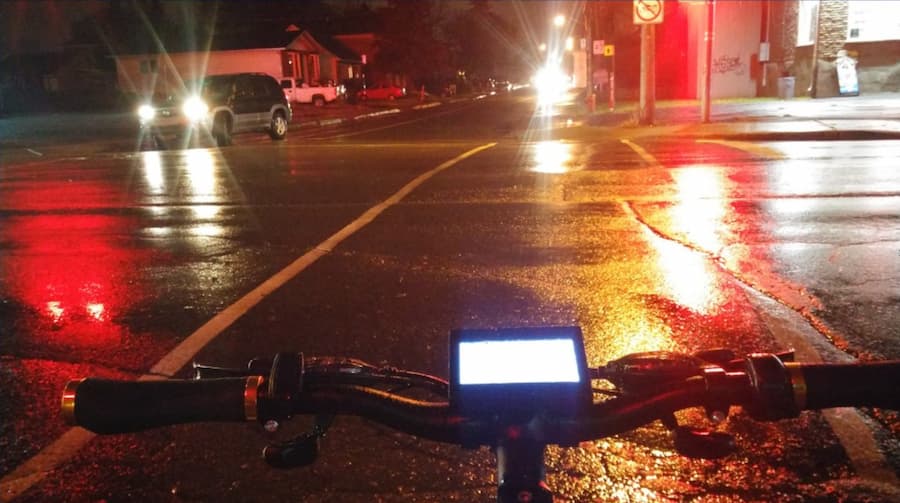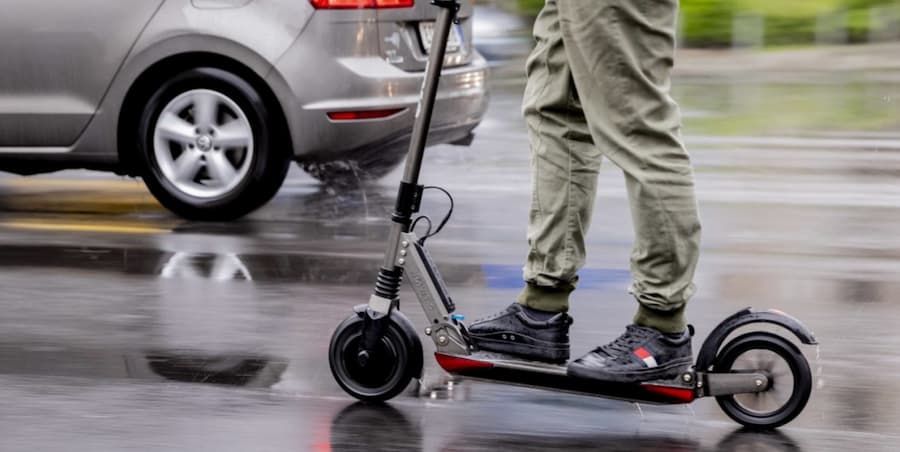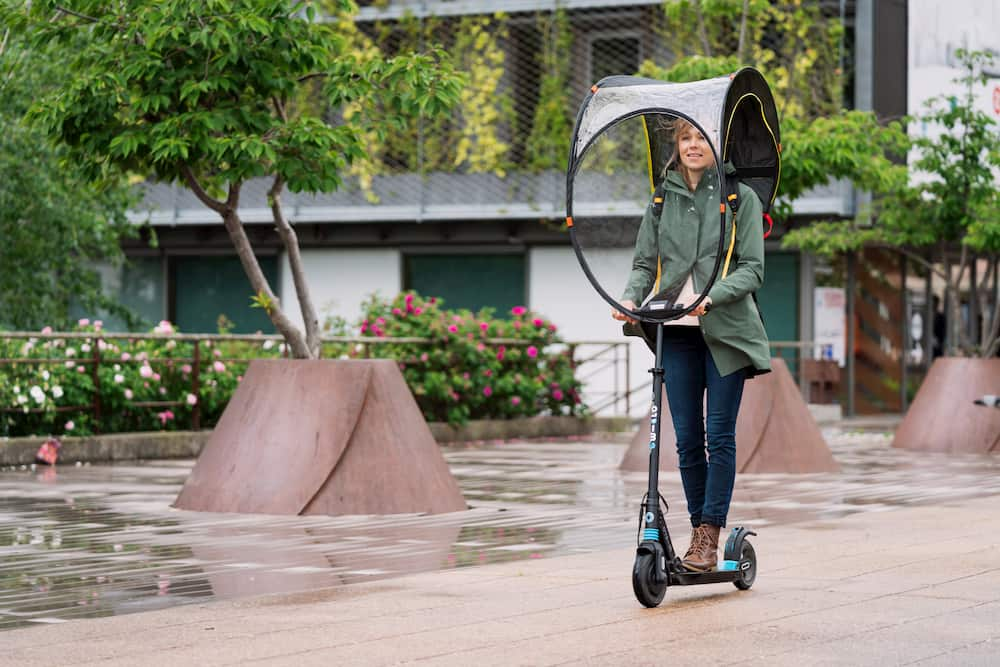With approximately between 40 and 180 days of rain per year in France (depending on the area), it is going to be hard to avoid riding under it…
Unless you live in a cave like an hermit, rain is always going to be something to plan ahead of during your daily travels.
Of course, it won’t necessarily be an issue if you use your car or the subway. Nevertheless, it is still constraining. Additional safety measures have to be applied, and your clothes are more likely to stick to your skin. But, with these constraints you can also be sure to arrive safely to your destination.
However, things might be less obvious if you are using an electric vehicle (such as an electric bike or scooter for example).
It is well-known that water and electricity do not go well together.
So, does that mean you can’t use an electric vehicle when it rains ? Or is there a device that is more resistant than the other ? How to ride in the rain ?
Keep reading, because that is exactly what we will explain in this article.
Can you actually use an electric bike or scooter under the rain ?
Don’t worry, this is not a “game show” so we are not going to make you guess the answer. Instead, we will tell you right away…
Yes indeed, electric vehicles can absolutely ride under the rain.
No need to put them away when autumn comes around. You will still be able to enjoy their benefits year round. At least, if you have chosen the right device. You might not know it but water resistance is not at all equivalent from one vehicle to another.
It’s an important criteria that you’ll have to check as soon as you think of buying one. But how ?
Don’t worry, you won’t have to throw a buck of water at it in the middle of the store.
Checking if your vehicle is water resistant is actually very simple. You just have to look at the IP rating, which is generally indicated on the tag or on the product specifications sheet.
The IP rating assigns a grade to the device. To understand it easily, take a look at the last number of that grade. For example, for the grade “IP56” look at the number 6. Generally, if that number is high, so is the level of water resistance.
For more information, here is a table that details the water resistance levels in regards to the most common grades :
| IP ratings | Water resistance level |
| IPX4 | Resistant to splashes coming from all directions |
| IPX5 | Resistant to a sustained and low pressure water jet spray |
| IPX6 | Resistant to a heavy and high pressure water jet spray |
| IPX7 | Resistant to immersion in water for at least 30 minutes at 1 m of depth |
| IP54 | Protected from water jet spray coming from all directions |
| IP55 | Protected from low pressure water jet spray coming from all directions |
| IP56 | Protected from high pressure water jet spray coming from all directions |
| IP57 | Protected from immersion into 15 cm to 1m of water |
While this rating is clear and easy to understand, unfortunately that’s not the whole story when it comes to riding under the rain.
Indeed, the IP rating only informs you of the water resistance of the battery. Thanks to that, you’ll know if you are at higher risk of damaging your vehicle or not.
However, it only focuses on the safety of your device during a rainy day, and not on yours. Which are two completely different things !
For your own safety, other factors are to be taken into account when riding on a wet and slippery road. Such as factors that focus on the design of the vehicle itself.
On that aspect, electric bikes and scooters greatly differ (even though they can have the same IP rating).
Electric bike or scooter : the best option for a rainy day
3 elements can explain this unevenness between electric scooters and bikes when it comes to rain.
The design :
First, it is the design of both of these devices that makes all the difference.
When using a bike, you ride seated. It is without a doubt more comfortable, but also even more stable ! An essential element when the road is slippery.
In contrast, it is not the same with an electric scooter. Firstly, because you ride standing up, which is a less stable position. In particular, because of the small deck where you have to ride with one foot in front of the other.
Secondly, because the decks of electric scooters tend to become slippery, in case of heavy rain and especially on entry-level devices.
Design wise : 1 point is awarded to electric bikes !
However, we would like to highlight an undeniable advantage regarding both electric bikes and scooters. Their design offers the possibility to install a Bub-Up®️. A rain protection bubble which allows you to stay dry at all times. The ideal way to arrive presentable at your meeting. Or simply to avoid getting a cold everytime it rains. With Bub-up®, you won’t need any additional rain gear most of the time (raincoat, jacket, parka, poncho, cape, etc.)
Braking :
Braking is another important element that impacts your safety in case of rainy weather. For the good reason that your braking distance might be lengthened because of a lack of grip on the wet ground.

Regarding braking, electric bikes are again safer. Indeed, they come with an efficient braking system both front and rear. This will allow you to stop directly and efficiently.
On the contrary, most electric scooters only have one efficient brake situated on the front wheel. The braking system of the back wheel is completely manual, or energy recovering. A less efficient mechanism.
Braking wise : 1 more point is awarded to electric bikes !
The battery :
Even though this section does not directly relate to your safety, we still wanted to underline it.
As you may know, we previously talked about the importance of the IP rating. You might think that it only can determine the waterproofness of your battery.
But that is not entirely true. The actual place where your battery is located matters as much as its level of water resistance.
A battery better positioned will always be better preserved than a battery more exposed.
Once again, on that topic, electric bikes and scooters are not equivalent.
On an electric scooter, the battery is placed close to the deck where your feet usually go. So, it is usually very close to the ground which increases the chances of getting it wet because of puddles or splashes of water.
On the contrary, the battery of an electric bike is located higher. This diminishes the risks of damaging it.
Moreover, the battery of an electric bike is easily accessible. So, if you ever need to leave your vehicle under the rain, you will be able to take it off very easily. However, it might be more complicated with an electric scooter as the battery is located inside the deck. To access it you will have to be able to open it which is an operation that often requires several tools.
We will end on the great score of the electric bike : 3 – 0.
However, we would like to highlight that no matter what, it isn’t the device that completely guarantees your safety. It also depends on your behavior on the road.
The 5 rules to follow to ride safely under the rain

To end this article, here are a few essential rules to follow in order to ride safely under the rain (whether you are using a bike or an electric scooter) !
Rule n°1 : Ride well-equipped
Equipment is more than ever essential under rainy weather. First of all, because the risk of falling is increased. But also because a suitable protection against the rain is primordial.
Here is the list of essential accessories you need for every outing :
- A helmet with a visor : the visor will allow you to maintain a clear vision at every moment. On a two-wheeled vehicle, you can quickly lose sight because of the mix of rain, speed and wind. That can be very dangerous especially in the middle of urban traffic ! So, protecting your eyes becomes indispensable. Your electric scooter helmet or electric bike helmet will also have to be chosen regarding your average speed. If you use the rain protection Bub-up, you wil not need a visor for your helmet because you will be able to protect your face, your eyes and eyeglasses.
- Waterproof gloves : not losing the control of your vehicle is essential to guarantee your safety. With rain water, standard gloves can quickly become slippery. To maintain a good maneuverability, don’t hesitate to invest in a pair of waterproof gloves.
If you also don’t want the rain to impact your level of comfort, you can also invest in some other practical accessories :
- Mudguards : if you don’t want to arrive at work covered in mud, this piece of equipment could change your life around.
- A visibility accessory : when it’s raining, it is important to see and to be seen! The Superbikero is the bracelet for all cycling superheroes. Thanks to its dual superpower, it combines a light signal with an integrated rear-view mirror. It is an innovative accessory that combines practicality and safety and can be used with any bicycle or e-scooter, including self-service models.
- A waterproof bag : whether you are carrying paper or electronic devices, this bag could become essential during all of your outings. Good news : both electric scooter bags and electric bike bags exist.
- A rain protection Bub-Up® : easy to carry, this protection will allow you to ride protected from the rain without needing waterproof clothing (jacket, parka, poncho, cape…).
Rule n°2 : Drive at an appropriate speed
Beware, when it is raining you will have to ride slower than usual. Don’t forget that because of the water, the road is more slippery.
The wheels of your vehicle won’t stick to the ground as much, and you’ll have more chances to lose control of it.
So, even if the speed limit is 25 km/h, consider slowing down as a precaution.
Be sure to anticipate braking ahead of time. Especially when it rains, progressive braking is preferable.
Règle 3 : Regular maintenance is a must
In order to avoid that the chain of your device becomes rusty or that water infiltrates into the electronic components, you need to care for it regularly. Especially if it rained heavily.
As a priority, don’t forget to maintain the wheels and brakes of your vehicle. Indeed, these two parts need to be in good condition at all times to prevent you from falling.
After a rainy ride, think of leaving your device inclined so that the water can flow out of it.
Rule n°4 : Protect your vehicle from the rain
Do not leave your electric scooter or bike outside under the pouring rain for too long. If you don’t have any other choice, then you can invest in a good tarp in addition to an antitheft device.
However, as soon as possible try to take your vehicle inside as there is no better protection against humidity.
Rule n° 5 : Check where you will be riding
In case of rain, try to avoid as many slippery surfaces as possible. Pay special attention to the white stripes of the road, which can sometimes be very dangerous.
Moreover, prioritize riding on asphalt surfaces rather than on muddy grounds as you could either slip or sink in more easily.





0 Comments